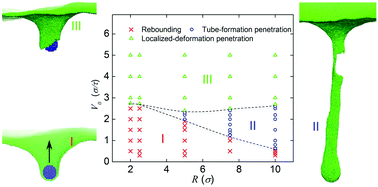Ballistic impact response of lipid membranes
Abstract
Therapeutic agent loaded micro and nanoscale particles as high-velocity projectiles can penetrate cells and tissues, thereby serving as gene and drug delivery vehicles for direct and rapid internalization. Despite recent progress in developing micro/nanoscale ballistic tools, the underlying biophysics of how fast projectiles deform and penetrate cell membranes is still poorly understood. To understand the rate and size-dependent penetration processes, we present coarse-grained molecular dynamics simulations of the ballistic impact of spherical projectiles on lipid membranes. Our simulations reveal that upon impact, the projectile can pursue one of three distinct pathways. At low velocities below the critical penetration velocity, projectiles rebound off the surface. At intermediate velocities, penetration occurs after the projectile deforms the membrane into a tubular thread. At very high velocities, rapid penetration occurs through localized membrane deformation without tubulation. Membrane tension, projectile velocity and size govern which phenomenon occurs, owing to their positive correlation with the reaction force generated between the projectile and the membrane during impact. Two critical membrane tension values dictate the boundaries among the three pathways for a given system, due to the rate dependence of the stress generated in the membrane. Our findings provide broad physical insights into the ballistic impact response of soft viscous membranes and guide design strategies for drug delivery through lipid membranes using micro/nanoscale ballistic tools.



 Please wait while we load your content...
Please wait while we load your content...